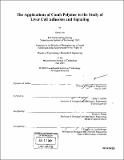| dc.contributor.advisor | Linda G. Griffith. | en_US |
| dc.contributor.author | Yin, David, 1973- | en_US |
| dc.contributor.other | Massachusetts Institute of Technology. Biological Engineering Division. | en_US |
| dc.date.accessioned | 2005-06-02T19:45:11Z | |
| dc.date.available | 2005-06-02T19:45:11Z | |
| dc.date.copyright | 2004 | en_US |
| dc.date.issued | 2004 | en_US |
| dc.identifier.uri | http://hdl.handle.net/1721.1/18044 | |
| dc.description | Thesis (M. Eng.)--Massachusetts Institute of Technology, Biological Engineering Division, 2004. | en_US |
| dc.description | Includes bibliographical references (p. 70-73). | en_US |
| dc.description.abstract | Comb polymer, which consists of a hydrophobic poly(methyl methacrylate) (PMMA) backbone with hydrophilic hydroxy-poly(ethylene oxide) (HPOEM) side chains, is a tool that has many possible applications for the study of liver cell adhesion and signaling. This polymer has the unique properties of being cell resistant and chemically versatile such that various cell ligands can be coupled to its side chains. These properties allow adhesion through specific cell receptors to be studied without the effect of background adhesion to adsorbed proteins. By taking advantage of the ability to target specific receptors the comb polymer could be used as a powerful sorting tool. Sorting could be accomplished by finding cell type specific adhesion ligands. Several possible such ligands were screened. A ligand containing the tripeptide sequence RGD was found to elicit a strong cell adhesion response. However, this ligand is adherent to many cell types of the liver and would not be suitable for sorting purposes. Other cell type specific ligands tested showed little to no affinity for liver cell adhesion. Additionally, the comb was utilized to study α₅β₁ integrin-specific hepatocyte adhesion and the effect of Epidermal Growth Factor on adhesion. α₅β₁ integrin adhesion was mediated using a novel branched peptide, SynKRGD. This peptide consists of a linear peptide sequence containing RGDSP and the synergy site sequence PHSRN connected by the sequence GGKGGG. By utilizing the amine side group of Lysine a GGC branch was added. The terminal cysteine was used to conjugate SynKRGD to comb polymer surfaces using N-(p-Maleimidophenyl) isocyanate (PMPI) chemistry. EGF has a great potential to benefit the field of tissue engineering due to its influence on cell | en_US |
| dc.description.abstract | (cont.) proliferation, migration, and differentiation. EGF is also known to have a de-adhesive effect in some cell types. Hepatocytes were studied on comb surfaces of variable SynKRGD densities with and without the presence of EGF in the media. Distinct morphological differences were observed for hepatocytes on substrates of varying adhesivity with and without the presence of EGF. EGF was found to have a de-adhesive effect on α₅β₁ integrin adhesion in hepatocytes. This effect became more pronounced as substrate adhesiveness increased. | en_US |
| dc.description.statementofresponsibility | by David Yin. | en_US |
| dc.format.extent | 73 p. | en_US |
| dc.format.extent | 5157454 bytes | |
| dc.format.extent | 5165006 bytes | |
| dc.format.mimetype | application/pdf | |
| dc.format.mimetype | application/pdf | |
| dc.language.iso | eng | en_US |
| dc.publisher | Massachusetts Institute of Technology | en_US |
| dc.rights | MIT theses may be protected by copyright. Please reuse MIT thesis content according to the MIT Libraries Permissions Policy, which is available through the URL provided. | en_US |
| dc.rights.uri | http://dspace.mit.edu/handle/1721.1/7582 | |
| dc.subject | Biological Engineering Division. | en_US |
| dc.title | The applications of comb polymer to the study of liver cell adhesion and signaling | en_US |
| dc.type | Thesis | en_US |
| dc.description.degree | M.Eng. | en_US |
| dc.contributor.department | Massachusetts Institute of Technology. Department of Biological Engineering | |
| dc.identifier.oclc | 57362962 | en_US |
